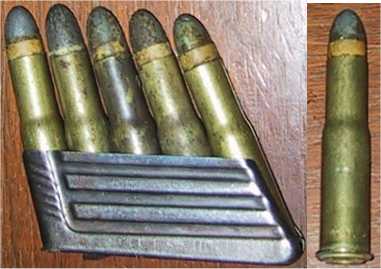Austro-Hungarian Werndl Infantry Rifles and Carbines (original) (raw)
Werndl Model 1877 Infantry Rifle
Infanterie- und Jagergewehre M1877

Made by �sterreichische Waffenfabriks-Gesellschaft, Steyr, 1878-85
Caliber: 11x58mm rimmed
Quantity: 300,000
Rotary-block breech, with an external hammer
1265mm [49.8"] overall, 4.20kg [9.2 lbs]
840mm [33.1"] barrel, 6-groove rifling, RH, concentric
Ramp-and-leaf sight graduated to 2100 paces
Muzzle velocity 455m/sec with M1877 rifle cartridge
M1873 saber bayonet
 |
Trials of improved cartridges in 1875-77 led to a better rifle, adopted in December, 1877. The principal differences between the M1873 and M1877 rifles - and the assorted conversions - lay in the sights; rifles chambering the new long-case 11x58mm M1877 cartridge would not fire the short-case 1867 pattern, though unconverted guns were deliberately left in the Austrian Landwehr and the Hungarian Honv�ds�g to expend existing supplies. |
|---|
 |
The 11x58mm cartridge was issued from December 25, 1878. It seems that no 1877-type rifles had been issued by this time, and thus that there was no need to re-graduate sights.Adoption of a relined propellant in 1881 raised velocity slightly (apparently to about 465 m/sec) and allowed the back sight graduations to be increased to 2200 paces. |
|---|
 After the introduction of Mannlichers, starting in 1888, Werndls were passed down through second-line and lines-of-communication troops to the Landwehr and then into storage. Survivors were reissued during WW1. A WW1 Ersatz bayonet shown.
After the introduction of Mannlichers, starting in 1888, Werndls were passed down through second-line and lines-of-communication troops to the Landwehr and then into storage. Survivors were reissued during WW1. A WW1 Ersatz bayonet shown.
Werndl Model 1877 Infantry Carbine
Karabiner M1877
 |
Made by �sterreichische Waffenfabriks-Gesellschaft, Steyr, 1878-85.Caliber: 11x42mm, rimmed.Rotary-block breech, with an external hammer.1004mm [39.5"] overall, 3.25kg [7.2 lbs].580mm [22.8"] barrel, 6-groove rifling, RH, concentric.Ramp-and-leaf sight graduated to 1600 paces.Muzzle velocity 307 m/sec with M1877 ball cartridge.M1873 saber bayonetThis carbine was approved to replace the 1867 and 1873-pattern carbines in 1878. The new cartridge was interchangeable with its predecessors, but much more powerful. Consequently, the 1877-pattern Kropatschek-designed sight was graduated to 1600 paces compared with only 600 for the original carbine round. |
|---|